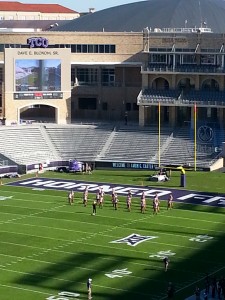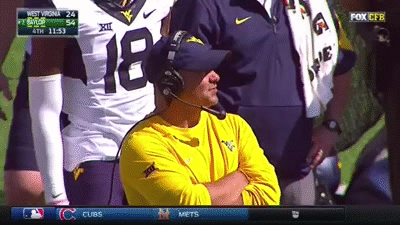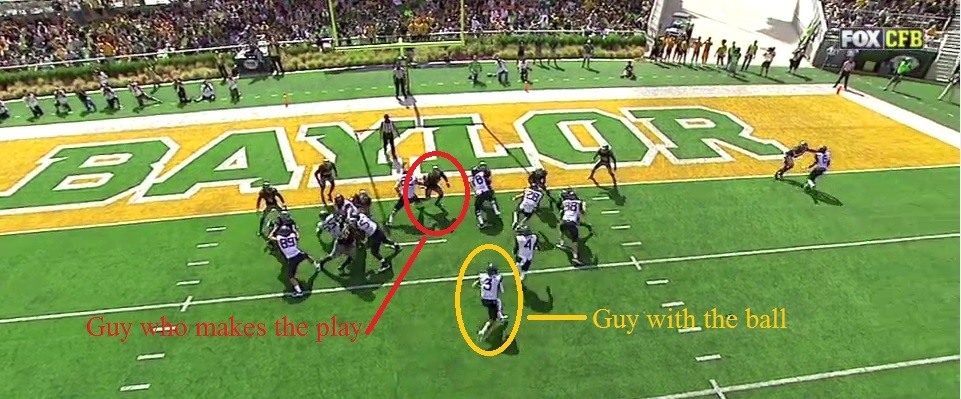No. 5 TCU 40, WVU 10
October 30, 2015 by Mike Casazza
The first half ended in a odd manner, and you thought it might matter, but then West Virginia goes double zero in the second half and loses by 30. Bad form, to say the least.
There are no coatings composed of sugar in Dana Holgorsen’s postgame review, but there remains a weird vibe about this squad: Who or what are they? Are they the 3-0 team or the 0-4 team. If you choose the latter, are they the 0-2 team on the front side of it or the 0-2 on the end of it? Or was last night’s game wholly different than the other three?
Continue reading…
WVU v. TCU: Is this thriller, thriller night?
October 29, 2015 by Mike Casazza
You are looking live at the dance team’s rehearsal for tonight’s football game. The gals, pictured wearing pink, because it’s October, are going to do Thriller tonight, also because it’s October. My longstanding belief is everything TCU does is pretty cool — marketing, media guides, uniforms, helmets with frogs shooting blood out of their eyes, formations (!), so on and so forth — so hopes are high, even though my head will be down and I’ll be writing and it’s possible I miss it.
But it’s Thriller. Thriller.
Also, it’a blackout tonight, which is not to be confused with Game 1 of the World Series.
https://twitter.com/TCU_Athletics/status/658646400364859392
Hopes are also high among the viewers that this will be a close, competitive and ideally offensive game tonight and the Fox Sports 1 audience will be entertained by another WVU-TCU meeting. I don’t know if that happens, but I do know this: You need to score points to win this one.
Trenchant.
In 20 Big 12 games this season, 18 have had a team score at least 30 points and six have seen both teams score 30 or more. WVU has hit 30 just once in three Big 12 games and allow me pin the * next to the final score at Baylor. The only two games without either team scoring 30 points involved Texas, which beat Oklahoma and Kansas State.
WVU’s averaging 29.6 points per game in Big 12 play — sixth place among the 10 teams, 9.9 points behind fifth-place Oklahoma State and 21.2 points behind second-place TCU — and that’s inflated by the Hefty Cinch Sak scores against the Bears. They count, and yet the Mountaineers are still under 30 points per game, and that’s a terrible place to be in the Big 12 and territory WVU was just not supposed to occupy in the past.
Since 2001, when West Virginia hired the offensive coordinator from Clemson and Rich Rodriguez accelerated heartbeats with promises of offenses that didn’t huddle and instead set hair on fire, the Mountaineers are 91-13 when they score at least 30 points.
He can take credit for much of that success, winning the first 33 times his offense scored 30 points and finishing 47-1 during such games in his seven seasons.
That sort of stuff began to matter, and his successor was Bill Stewart, who reached 30 points five times in his first season and then in the first five games in 2009. He stockpiled substance with 18 wins and a bowl victory his first two seasons, but the style was in short supply.
There were no more 30-point games to finish the 2009 season, and the athletic director decided to make a change in the middle of the 2010 schedule. The Mountaineers hit 30 points three times in the first five games that year before a stretch of 20, 14 and 13 points had Oliver Luck informing Stewart his days were numbered.
Stewart’s successor was another offensive coordinator with a flashy reputation, and though Dana Holgorsen’s first season was not without some offensive pitfalls, the Mountaineers did set all kinds of scoring records when they beat Clemson 70-33 in the Orange Bowl. That and an 8-1 record with 30 or more points plotted a promising future in the Big 12, where teams need a potent offense as much as they need a football.
Sure enough, WVU went for at least 30 points in seven of nine Big 12 games in 2012, but that was only good enough for a 4-5 conference record. In the 21 conference games since, the Mountaineers have but 13 30-point games and a 6-7 record in those contests. WVU reached 30 points in overtime of two games and in meaningless moments of two one-sided losses to Baylor.
After the most-recent lopsided defeat against the Bears on Oct. 17, Holgorsen admitted this offense wasn’t advanced enough to keep up with an offense as sophisticated as Baylor’s. Tonight’s opponent is No. 5 TCU, and the fifth-ranked Horned Frogs welcome the Mountaineers to Amon G. Carter Stadium for the 7:30 p.m. Fox Sports 1 game.
The Horned Frogs will greet West Virginia with a Big 12 offense that is second only to Baylor in scoring (50.1 points) and total offense (616.3 per game).
The Mountaineers, quite simply, have to keep pace.
“I would like to get to a point where we can,” Holgorsen said. “I’ve been involved in some games where it’s been fairly high-scoring games. We just haven’t been there yet.”
Oh, hey. I’m open. Hit me in the post.
Continue reading…
You’ll Never Talk Alone: S4E7
by Mike CasazzaAs usual, we’ll begin at 11 a.m. and go for about an hour. You can throw your questions in the queue now, you can follow along live or you can catch up afterward. Keeping up is sort of the key today, no?
Introducing Tony Gibson’s Cover 11 scheme
October 28, 2015 by Mike Casazza
I have no idea of this is for real, and I suspect it’s not because it’s so extremely absurd, but Tony Gibson said it as both a matter of fact and a matter of emphasis.
“You’re going to see us do a lot more stuff. I may drop 11. Don’t be shocked if you see that.”
Um, I’ll be shocked. It’s the polar opposite of Gibson, and though it’s an exaggeration (I think), it’s also the possible representation of the realistic state of affairs.
Continue reading…
Tuesday Taboo: Accessible thoughts
October 27, 2015 by Mike Casazza
Called an audible this week for a couple of reasons, namely because I think this is important, but also because I ended up writing about David Sills V. Did you know he’s close to a scratch golfer and was a state champion wrestler when he was younger? Impressive kid who, we suppose, has to take on a bigger role in the offense.
“Even when USC was recruiting him, they kind of had a thought that he could play this way as well,” Clarkson said. “As a quarterback, that’s what made him so intriguing. He’s such a great athlete, and no one saw that as a 13-year-old.
“I saw it, but he was seen as a pro-style quarterback, or whatever you call it, and he was miscast his entire career. People saw him as a drop-back guy and didn’t think he was a good athlete, which was stupid.”
It was just one day, and that wasn’t enough to completely validate Clarkson’s strong opinions of Sills, but it might also be true that the first game was just the beginning. Clarkson has compared the 6-foot-3, 190-pound Sills to 2012 Heisman Trophy winner Johnny Manziel before, and he’s not backing away now.
“I think he’s a taller version,” Clarkson said. “I think it’s an accurate comparison, but he could just be the first David Sills. He does a lot of things that just wow you that you can’t teach. I’d love to see them really maximize his talent level, because they’re in a very unique situation now. His redshirt is gone, so if you’re going to put all your chips in the middle of the table, it’s not about the future. It’s about now. You’ve got to let it ride.”
Dana Holgorsen: TCU week
October 26, 2015 by Mike Casazza
There are no injury reports within, but know that Wendell Smallwood declared himself 100 percent and that that’s about all the good news on the player personnel side of things.
News for WVU's Weight Watchers secondary: Doesn't sound like T. Chestnut (shoulder) will play v. TCU, R. Rumph (death in family) will not.
— Mike Casazza (@mikecasazza) October 26, 2015
Chief among the many, many concerns attached to that is TCU’s offensive supremacy on third down and the state of disrepair of WVU’s heretofore effective third-down defense packages.
Swag.
October 23, 2015 by Mike CasazzaICYMI, the Red Panda is back for the OU game. Buy a mini-package for the OU, BU and OSU games for $75. 1800WVUGAME. pic.twitter.com/tb2XCFwxOB
— WVU Men's Basketball (@WVUhoops) October 23, 2015
I’m out of pocket, and for my own health I vowed not to use technology this weekend, but this supersedes that.
Continue reading…
The Good and the Bad of WVU v. Baylor
October 22, 2015 by Mike Casazza
This all feels very weird today. I’m a day behind. I’ve got basketball in my head. And I honestly can’t give you a whole lot that distinguishes itself from many other things you saw, heard or read to explain the loss or to add to that which you believe or were made to believe after the loss.
And I sort of warned you in TFGD, albeit in jest, that a bunch of what I’d say here could boil down to “That’s Baylor!” Granted, that’s not a very good explanation, and I think in Year 4 of the Big 12 experience and a season after beating the Bears, that ought not apply or be applied quite so frequently. I also think there were occasions West Virginia had to and could have been better — Shelton Gibson dropping a certain touchdown pass in the fourth quarter, for example — and the justifications for why the Mountaineers were not simply do not cut it. So I’ll try not to bow to the Bears, but there will be things I can’t resist because this is G&B and there were some bad men doing Good things Saturday. It made West Virginia look Bad, but there were some instances in which I thought the Mountaineers could do very little about that.
I mean, that trips formation with the bunch to the short side of the field and a 1-on-1 on the wide side? Good luck. I really don’t know how you defend that unless, as Tony Gibson proposed, you’re allowed to use 14 players.
But here’s my lede today: Baylor’s playing fast break football. The offense is just nuts. It’s frenetic and efficient all at once. The space is potent and the players make it lethal. Players are hitting all their marks in multiple aspects. I’ve just never seen an offense affect the other offense quite like this. Baylor’s played this offense before, but Baylor’s never played offense like this before. I hope that makes sense. Watch this in the future: Offensive players on the other team perform with a pending doom resting atop their shoulder pads. I don’t care what those players say. It’s true. You know every incomplete pass, every negative-yardage run, every time you leave yardage to go for a first down, every field goal is potentially damning. That’s certainly not reality, but it does feel real.
What I hadn’t really paid much attention to is that Baylor’s defense is in a hurry to put the offense back on the field. The Bears are aggressive. They blitz a lot. They hit you. They swarm. (They look a lot like WVU looked against Baylor last season, I thought.) They’re trying to force errors or punts, and if they get beat in the form of a touchdown or a long gain that precedes a touchdown, fine, just let Seth Russell & Co. handle that.
The whole experience is a bit frightening. You know it going in, and when you start to feel it, that can be very hard to manage.
I said this in the chat last Thursday, but I suspected the game might get away from WVU in the first half. The Mountaineers were enduring slow starts. Skyler Howard’s first halves were costly. If there were some punts or stumbles or field goals, they could pay with quick Baylor strikes. That did not happen, and I thought Dana Holgorsen, the offense and the defense were pretty good in the first half.
But that game was over at halftime.
Baylor created a few openings. There were dropped passes. There was an early fourth down attempt. There were two punts. WVU hit some big plays (against a passive defense) and drove to the red zone. But the results? WVU gave up a first down on the fourth down and then a touchdown a play later. After the two punts, the Mountaineers managed three points, and that was on one of the red zone possessions. Those three points were negated by a WVU punt and a Baylor field goal. Another red zone possession ended with a missed field goal, and a healthy Wendell Smallwood probably scores on that 52-yard run, and that takes the specter of a field goal out of the equation.
The Mountaineers had 17 points at halftime, which is a pretty good half for them lately, and they were down 10. Not only that, but they knew they had their chances and gave them away with punts, missed and made field goals and an interception in the end zone. They had some looks and looked the other way. The first drive of the second half then became enormously important. WVU punted, Baylor put on a hellacious stretch with 28 points in 24 plays, and that was that.
The Bears are not perfect, but they cover for a lot because opponents know they’re so damn close.
So there’s my conclusion. How did we get here? Let’s find out, by taking a look at the God and the Bad of WVU v. Baylor.

My apologies in advance.
Continue reading…
Smart man, that Texas coach
October 21, 2015 by Mike Casazza
There’s a new face and another Final Four coach in the Big 12, and Shaka Smart also happens to be an advocate of full-court pressure defense. While digging up how Big 12 teams coped with and beat West Virginia’s press last season — and what missteps WVU ought to avoid — we discovered that Smart was a detached fan of what the Mountaineers were doing.
“You always try to learn from people who do things at a high level,” Smart said Tuesday at the annual Big 12 media day.
Before the start of last season, the Mountaineers had never in the history of their program finished a season leading the nation in a statistical category. When Duke was cutting down the nets in April, WVU was No. 1 in total steals, steals per game and forced turnovers. Those superlatives, plus another top ranking in offensive rebounds per game, led the Mountaineers to 25 wins and a Sweet 16 appearance.
“I don’t think they got enough attention, actually,” Smart said. “What they did was so unique relative to what other people have done in the last several years of college basketball. The numbers they created in terms of turnovers and steals are impressive.”
As Smart watched, he remembered what Huggins used to do at Cincinnati, when he’d pressure opponents but never with the ferocity or persistence Smart was witnessing. He compared it to his presses that overwhelmed teams first in the Colonial Athletic Association and then in the Atlantic 10, but this was different.
“What they did, particularly late in the year, their guys played with a level of aggressiveness and passion and relentlessness that was as good as you’ve seen in the full-court press since the 1990s, when Kentucky and Arkansas were playing that way,” said Smart, 38, who shocked and trapped people all the way to the 2011 Final Four.
Smart and Iowa State’s Steve Prohm are new to the league this season, and what a league it figures to be. Fortunately for them, their situations are good ones in a conference stacked with favorable rosters.
Search this blog
Recent Posts
- Derek Redd reveals his AP Top 25 ballot, Part 1
- WVU basketball finishes season at No. 24 in AP Top 25
- VIDEO: WVU coach Bob Huggins’ Wednesday press conference at the Big 12 basketball tournament
- VIDEO: WVU players speak to the media Wednesday at the Big 12 basketball tournament
- Big 12 addresses Coronavirus concerns ahead of this week’s basketball tournaments in Kansas City
Recent Comments
- on VIDEO: WVU players react to Wednesday’s loss against Kansas
- on VIDEO: WVU players react to lopsided win against Iowa State
- on WVU’s Bob Huggins thinks rule change aims to ‘eliminate post play all together’
- on Mountaineer Matchups: WVU visits TCU for final game of 2019 season
- on VIDEO: WVU quarterback Jarret Doege on the Mountaineers’ win at K-State


